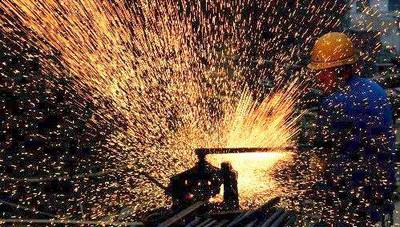
GRADUALLY IMPROVED steel prices do not seem to be enough to boost profitability at China’s steelmakers, as 77 medium-to-large producers showed significantly diminished sequential profits last month.
June net profits for the polled steelmakers totaled 6.25 bln yuan, down nearly 40% from the 10.04 bln recorded for the same firms in May, and things are looking even bleaker for the July-August period.
The government cut export tariff rebates on several steel product categories beginning July 15, but analysts say this in and of itself is not enough disincentive to keep domestic producers from hoping to offload their excess output abroad.
Despite the overall oversupply situation, June steel output was the smallest this year since February.
China need not worry about losing its place globally, as it still accounts for 45% of global steel output and a whopping 64% of seaborne iron ore trade.
Baosteel, the largest publicly traded Chinese steelmaker, announced in mid July that it would cut prices for a second month amid weakening demand, but this week's price increase might help stop the bleeding.
|
||
Domestic mills have curbed output, with Chinese production falling to 53.8 mln tons last month, 4.2% less than in May.
Much of the profit declines last month can be blamed on the diminished June production, which fell primarily due to intensifying industry consolidation campaigns in the country, but the weaker bottom lines are even more due to soft selling prices.
Total profit for the first six months was better, with the 77 steelmakers' combined bottom line hitting 50.72 bln yuan, which is a more than 22 fold increase from the year-earlier period.
"The most troubling aspect to the survey is that even as the industry consolidates, although in theory the smaller number of competitors should be seeing larger overall profits. However, that is not necessarily the case,” the Chinese language piece in SinaFinance said.
It added that China’s steel industry had entered its “most challenging” period of the year.
"Steel prices are also likely to soften going forward with the July-August period seen as even bleaker.”
|
||||||||||||||||||||||||||
The primary driver behind diminished profitability last month was the fact that while total output fell by 2.9%, average prices in June fell by a whopping 15% from May levels.
"The tiny sequential decline in average daily output is nominally good news – better than an uptick – but sobering to realize with pricing down some 15% in the region in the face of higher costs.
"We are stunned by the lack of financial good sense by China’s high cost steelmakers who continue to turn gold into straw – producing high cost steel at a breakneck pace and accelerating exports to post-recession highs in order to funnel the overproduction back into the global market,” said a separate analyst report from Steel Market Intelligence.
The report in SinaFinance added that after China raised the tax rebates for steel product exports in past months, the resulting increase in overseas sales has concurrently led to a rise in protectionist sentiment abroad, which it said is "increasingly a problem” for export-oriented Chinese steelmakers.
"This is causing major headaches for China as it tries to solve its overcapacity situation. The severity of the problem is illustrated by recent figures fro 20 cities across the country that showed their steel inventories had reached a new high of 15.1 mln tons, up nearly 75% from a year earlier!"
With all the excess capacity in the industry and growing inventories across the country of steel products lowly rusting, it is no wonder that profitability last month was so grim for the 77 polled producers.

The domestic oversupply situation is exacerbating an already weaker pricing environment.
With more cheap excess capacity in China, the industry’s attempt to export itself back to profitability will undoubtedly bring increasing criticism from major trading partners, who themselves are mired in a two-year long economic malaise.
From mid-April of this year, the benchmark steel price in China and the region has been steadily falling.
One more telling example is the critical product category of hot-rolled coil steel, which in the Shanghai market is now selling for 3,830 yuan per ton from a recent high of 4,600 yuan just three months ago.
Critical construction-use steel products fell from 4,340 yuan to 3,600 yuan over the same period.
Investors in listed steelmakers such as Baosteel, Angang, Wuhan Steel and Maanshan – one of China’s top providers of railway wheels – would do well to keep a close eye on the chronic overcapacity problem in the country and how the industry chooses to remedy it – through production cuts, continued consolidation, or a new surge in exports.
See earlier story on huge potential order boost for steelmakers:
12 BLN USD Argentina rail deal sends China rolling stocks soaring







